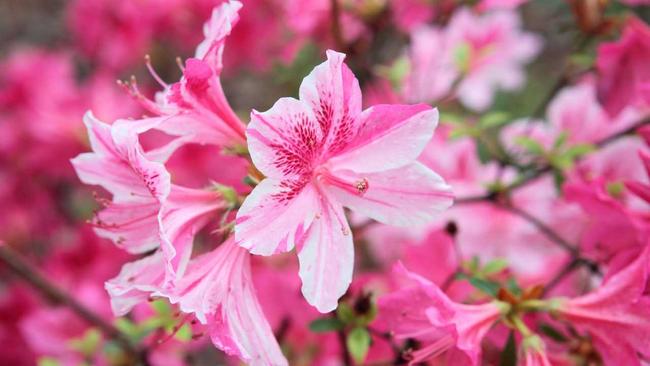Gardening: Azalea ablaze with colour
The forgotten azalea puts on a stunning show in spring

Opinion
Don't miss out on the headlines from Opinion. Followed categories will be added to My News.
AZALEAS maybe aren't as popular as they were 10 or 20 years ago. I'm not sure why because there is a lot to like about these lovely flowering shrubs.
They do not get too big, and they flower profusely over a long period, often a couple of times a year.
They are at their most spectacular in spring, when the bushes may be so smothered in flowers that the foliage is completely hidden.
The flowers may be single or double, large or quite small, and are held in clusters. The colour palette ranges from white to pastel pinks to bold reds, oranges and purples. The plant size can vary from the miniatures, only 30cm high, to large 2.5-metre shrubs.
Most azaleas prefer part or dappled shade, although some varieties, usually those bearing single flowers, will grow in full sun.
They love a well-drained, slightly acidic soil that is rich in organic matter. Azaleas are quite shallow rooted, so they benefit from a layer of mulch to help keep the root zone cool and to conserve moisture.
They grow beautifully in pots, and can even be enjoyed indoors for a few weeks during flowering time. If you're growing your azaleas in pots, make sure you use a specific azalea potting mix and choose a pot that is not too big for the plant. The miniature forms are often used in bonsai.
After flowering is finished, usually in late spring, cut them back by about one third, and apply a suitable fertiliser at the recommended rate.
Azaleas are a great choice if you need to add some colour in the dappled shade cast by established trees. They look quite at home in Japanese-style gardens as well as classical, cottage and country gardens. Combine them with camellias, gardenias, plectranthus Mona Lavender or cliveas. Plant them en masse to achieve a sensational spring show.
While they are easy to grow, they aren't completely pest-free. Loss of colour, or silvering, in the leaves is usually the work of the tiny azalea lace bug.
They suck the sap out of the leaves, which may then fall prematurely. If the infestation becomes very severe, it may kill the plant. We used to recommend Confidor to treat this, but now that we know that Confidor is toxic to bees I don't think we should use it. Neem oil sprays have been effective in trials, so use that instead.
Azaleas growing in hot, sunny positions are more susceptible to attack from lace bug and other insects, so you can limit the damage by providing ideal growing conditions.
Natural predators of azalea lace bugs include assassin bugs, lacewing larvae and lady beetles, so encourage them into your garden by limiting pesticide use and cultivating plants that will attract them.
Petal blight is the other most common problem. This is a fungal condition which causes the flowers to turn brown and mushy. Reduce the risk by avoiding overhead watering, and treat it if necessary with Eco-Fungicide.
Got a gardening question? Email maree@edenatbyron.com.au.


